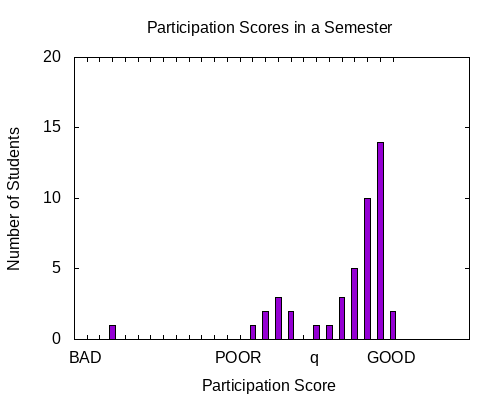Participation Points
This course uses learning groups as a fundamental learning technique. As such, a student not meeting the learning group's expectations handicaps the other group members with more work.
Learning Group Expectations
These are the expectations of students in learning groups.
- Attend lecture.
Share equally the work required for the learning group assignments. Recall that learning group assignments are written to be more work than a single student is expected to complete for a three credit-hour course. This is one reason groups are used — so more can be learned.
Complete your portion of an assignment following the question's instructions. In part this means:
Your contribution must be more than the answer, it should demonstrate how your answer was arrived at, and any logic or arguments supporting your answer.
- Write your solutions out in a clear manner, be prepared to show others the how and why of your answer.
Do not, for instance, write Python code when the assignment says "pseudo-code"; or write a flow chart when a state diagram is specified.
If you complete your work in electronic form, then Email your solution to group members before, ideally the night before, the next lecture. Five people cannot huddle around one netbook screen and learn — this simply does not work. If your solution is printed out or hand written in a "small" format, consider making a couple copies or extra printouts to share with your group members during the learning group time --- it is certainly more efficient to simply write larger

 You are allowed to share all written group work, do not share your graded individual assignments (such as your simulation projects).
You are allowed to share all written group work, do not share your graded individual assignments (such as your simulation projects).
Notice that you and your learning group negotiate how work is divided. You are not required to do something for every assignment — but if your group agrees to let you skip the work for one assignment (perhaps another big exam you must study for?) then they should rightfully expect you to make it up by completing a larger portion of a future assignment.
Randomly Evaluated Participation Grades
The instructor(s) will circulate during the initial learning group time and randomly select students for a participation grade evaluation. Usually this will mean showing the instructor your work for the learning group assignment, and you will receive either a Satisfactory or Unsatisfactory evaluation on the spot, based on the expectations mentioned above.
If you've had a hard time working through a question (yes, some of them are intentionally hard), perhaps you don't have a solution to show for a grade — that's OK. Show evidence of your attempts at the problem; speak to thoughtfully about what made the problem hard; show you've made an effort to find a solution, and you will get a satisfactory grade.
If you took the assignment "off" with the agreement of your group members, then your the grade for that day will simply be skipped.
- In extreme circumstances your learning group may lobby the instructor on your behalf, but they don't have "veto power" over the instructor's grade.
As with any other graded work at Mines, excused absences are allowed for participation grades. In these cases, the student's participation grade will simply not be recorded on that day. This will not adversely affect the students final course grade.
Participation Grade Outcomes
Your participation grade will fall into one of three categories:
|
In Lecture |
Excused Absence |
Absent |
Satisfactory work |
|
|
|
Unsatisfactory |
|
N/A |
|
Clearly you want ![]() s, not
s, not ![]() s, and certainly not
s, and certainly not ![]() s.
s.
Peer Evaluation
At the end of each learning group round, members will evaluate each other in three categories:
- Presentation of your work (you are the teacher sometimes!)
- Quality of work
- Group participation
Peer evaluations may be used to support "bumping" a student up a course grade for borderline cases; evaluations are also used by the instructor to support scholarship, job, or school recommendations requested by the student.
Course Grade
At the end of the semester, we will count satisfactory participation grades for each student
where the vast majority of the students have very good participation scores.
Based on the distribution, a threshold will be chosen (for the graph above, let's say q). All students with at least q participation score will not have their final course grade diminished.
Students with participation score of < q will have their final course grades reduced (curved down).
Threshold Guarantees and Caveats
From semester to semester the threshold will vary, but it is guaranteed to be less than the first quartile of the distribution. As such, 75% of the students will not have (negative) participation grade adjustments made. Be an active and contributing member of your learning group, and you do not need to worry about the participation grade.
The graph above is NOT a distribution of course grades. Understand this: a "C" or "D" student can have a really good participation grade by simply being a reliable, active, and contributing member of their group.
Poor participation in your learning groups will have a negative affect your course grade --- regardless of how well you do in all the other graded components of the course.
Periodic evaluation of participation grades may justify the removal of a student from the learning group rotations.
The instructor may choose to use the participation grade to boost students' course grades. If so, it will be done in a uniform manner for all qualifying students.
